The mere mention of Hampi evokes thousands of feelings in our hearts. Once the capital of the esteemed Vijayanagara Empire, Hampi has now enlisted as a UNESCO World Heritage Site thanks to her architectural and sculptural remains.

Table of Contents
Know before you go: all about Hampi:
Hampi was originally known as Pampakshetra. It was named after Pampa, a reincarnation of Sati. Pampa had fallen in love with Shiva, who was then meditating at Hemkuta Hill. Eventually, Shiva was impressed by Pampa’s dedication and married her. In fact, Shiva is known as Pampapati in Hampi. Also, Hampi is a contorted term derived from the word ‘Pampa’.
In Ramayana, Hampi was called Kishkindha. It was the kingdom of monkeys. It was from here that Rama embarked on his mission to rescue Sita from Lanka.

Historically, Hampi was the capital of the mighty Vijayanagara Empire. It was the second largest city of the Medieval Age. It was also the richest city in the contemporary world. Foreign visitors from Persia, Italy, Portugal, and Russia have left chronicles of a prosperous city, which was conquered by the Deccan Sultanate troops in 1565 CE, ravaged for six months, and then abandoned.
Know more about Hampi from our previous blog post here.
Where is Hampi located:
Hampi is located in central Karnataka, near the state border with Andhra Pradesh. It is situated on the banks of the Tungabhadra River. It is 376 km from Bengaluru and 165 km from Hubli.

How to reach Hampi:
- By air: The nearest airport is at Torangallu (32 km from Hampi), which, in turn, is well–connected with Bengaluru by air.
- By rail: Hospet (13 km from Hampi) is the nearest rail station.
- By bus: Overnight bus services are available from Bengaluru.
As for us, we reached Bengaluru from Kolkata by flight. Then, we boarded the train from KSR Bengaluru station. We reached Hospet at 7 AM after an overnight journey. From Hospet, we took an auto to Hampi. The auto charged INR 250.
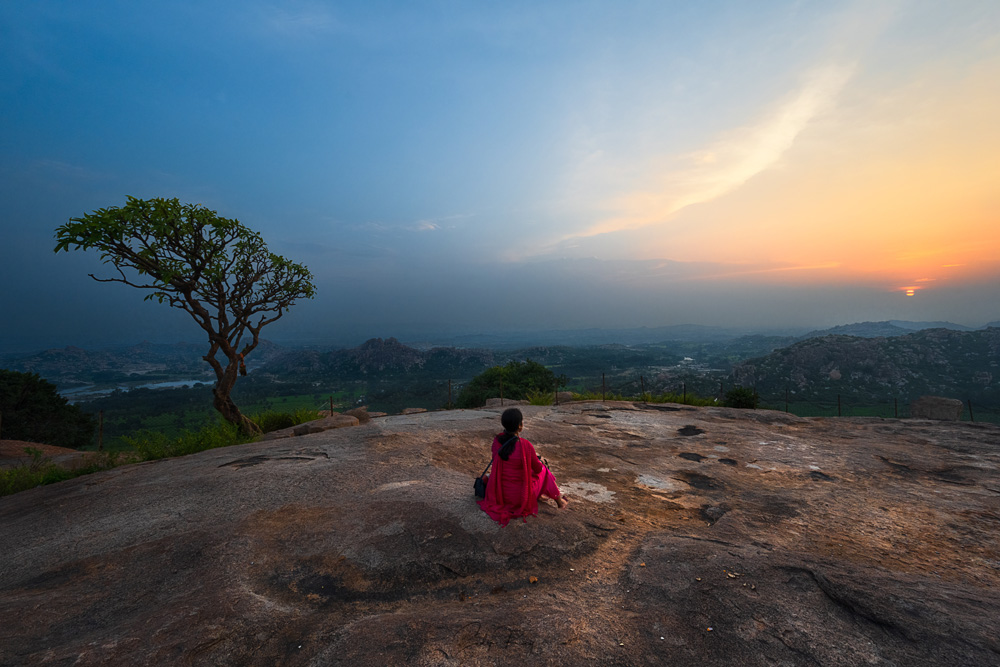
What is the best time to visit Hampi:
Given its rocky terrain, Hampi remains excruciatingly hot during most part of the year making it extremely difficult to explore the ruins. Hence, it is best to visit Hampi from October to February. The temperature remains moderate and the chances of rainfall are almost nil during this time.
How to travel within Hampi:
The most convenient way to travel in and around Hampi is by auto. The daily fare of an auto is around INR 1000. Don’t forget to bargain a bit.
You can rent a scooter and bike at INR 200 – 300 per day depending on the type of vehicle.
You can also rent bicycles at INR 100 – 150 per day.
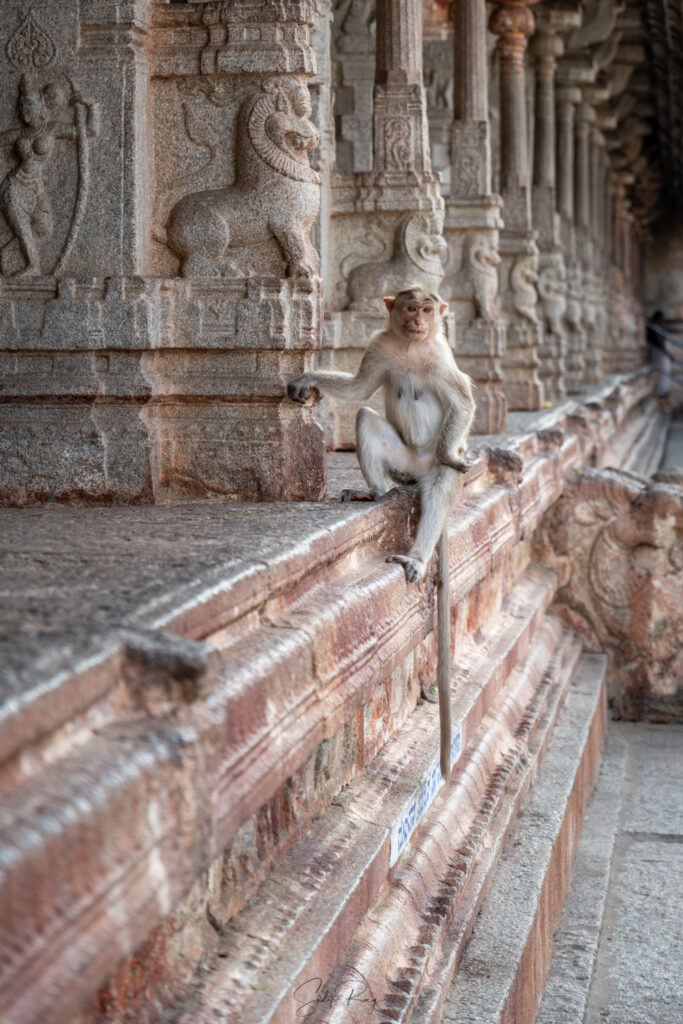
Where to stay in Hampi:
We stayed at KSTDC Mayura Bhuvaneshwari at Kamalapura. The room was decent and provided with all amenities. We also loved the food here. The staff are cordial too. You can check the current room rent and book rooms from here.
The Clark’s Inn Hampi is another good option for accommodation. This hotel is located just opposite the Archaeological Museum.
Books on Hampi:
We will suggest reading about the Vijayanagara Empire before travelling there. It will help you to understand the history of Hampi and thereby feel this amazing place. Read “A Forgotten Empire” by Sewell and “Hampi Vijayanagara” by Fritz & Michell.

What are the things to do in Hampi:
1. The best and most important thing to do here is obviously to explore the countless ruins of the Vijayanagara Empire.
2. Sunset in Hampi is regarded as one of the best in Asia. Watch beautiful sunsets from Hemkuta, Matanga, and Anjanadri Hills.
3. Take a coracle ride on the Tungabhadra River, especially during the sunset.
4. Don’t forget to visit the Archaeological Museum. True, Hampi is often considered an open museum. Yet, its museum houses some spectacular and important relics of Vijayanagara.
5. Explore the rural side of Hampi. The paddy fields, coconut groves, and banana plantations add to its idyllic beauty.
6. If you are up for an adventure, you can go rock climbing in Hampi.
7. Hampi is also known for birding.
8. You can also visit the Daroji Bear Sanctuary to see sloth bears.

How many days are enough for Hampi:
No matter how many days you stay at Hampi, you will end up wishing to spend a few more days there. Alas! If only, our bosses at work understood!
Ideally, 3 days will be sufficient to explore Hampi. We spent 3 days and covered even some of the off-beat places here.

In this blog, we will share our very own itinerary. Along with that, we will also chalk out itineraries for 2 days and 1 day. You can modify them at your convenience.
Day 1:
On our first day, we started our exploration by visiting the following places in and around Kamalapura:
1. Vijaya Vittala Temple:
This is one of the most important temple ruins of Hampi. It is considered a masterpiece of Vijayanagara temple architecture. Since it remains crowded for a good part of the day, we visited around 7 in the morning.

On entering through the eastern ‘gopuram’, the magnificent stone chariot grabs all the attention. The stone chariot believed to be inspired by Konark’s Sun Temple, is undoubtedly one of the most popular tourist attractions here.

Later, we took the dirt road on the left of the Vittala Temple and reached the King’s Balance. The Vijayanagara emperors are believed to have had themselves weighed on this balance against gold and precious stones, which were later distributed among temple priests.
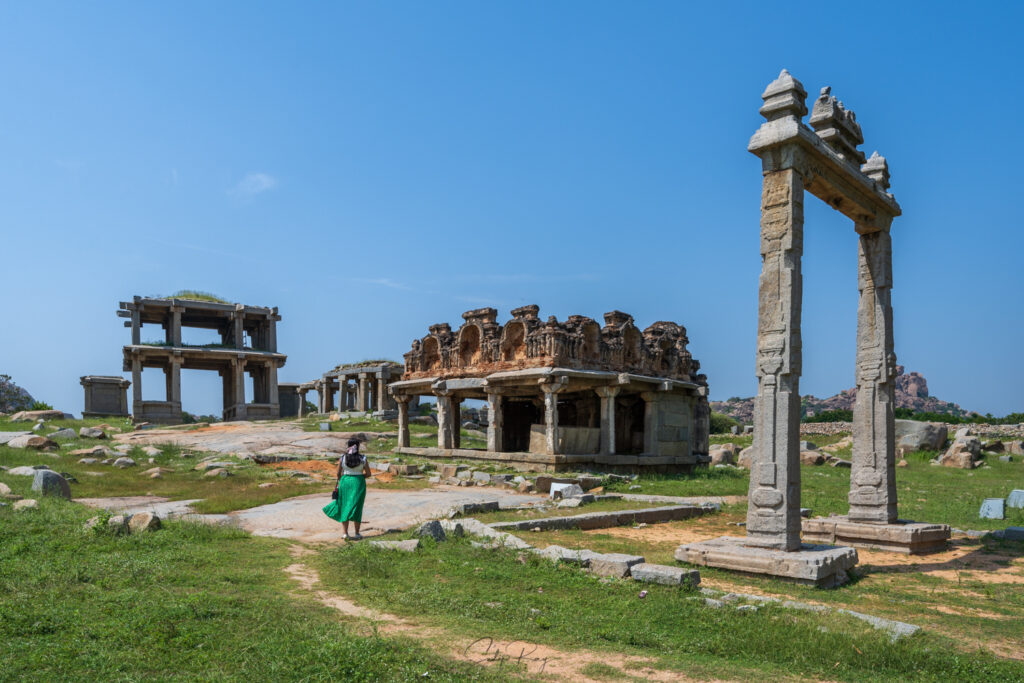
2. Malyavanta Hill:
This place is laced with tales from Ramayana. Rama is believed to have spent four months here while looking out for Sita. The relief carvings of Shiva lingams and Nandis found on the hill were worshipped by him. We were also captivated by the panoramic view of Hampi from above Malyavanta Hill.
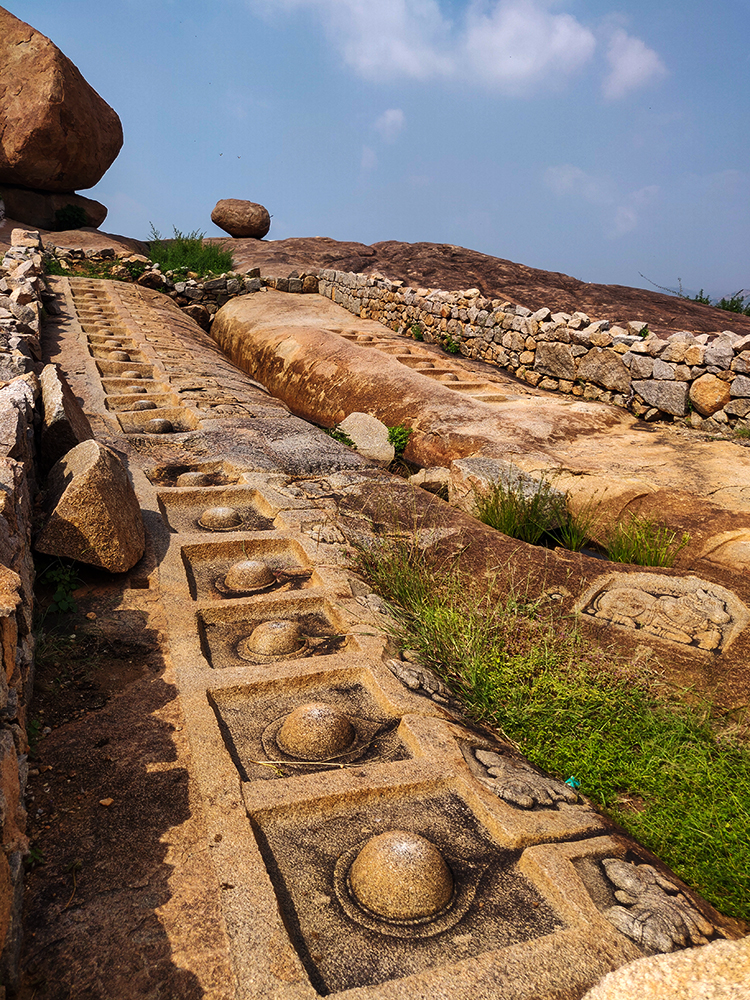
The summit of Malyavanta has the beautiful Raghunatha Temple. It is only in this temple that Rama can be found worshipped in a seated position.
3. Bhima’s Gate:
Next came Bhima’s Gate. A slab carved with Bhima, Mahabharata’s hero, was found here, hence the name.
4. Ganagitti Jain Temple:
An inscription of 1385 CE on the ‘dipa-stambha’ mentions that this Jain temple was built by Irugappa, a general of Harihara II. The structure of this temple is quite simple and austere in style with plain outer walls.
5. Pattabhirama Temple:
Our next stop was Pattabhirama Temple, which is one of the largest temple complexes in Hampi.

The temple was dedicated to Lord Rama. It was probably built by Achyutaraya of the Tuluva dynasty. It once formed the nucleus of an urban cluster called Varadevi Ammana Pattana, named after one of the queens of Achyutaraya.
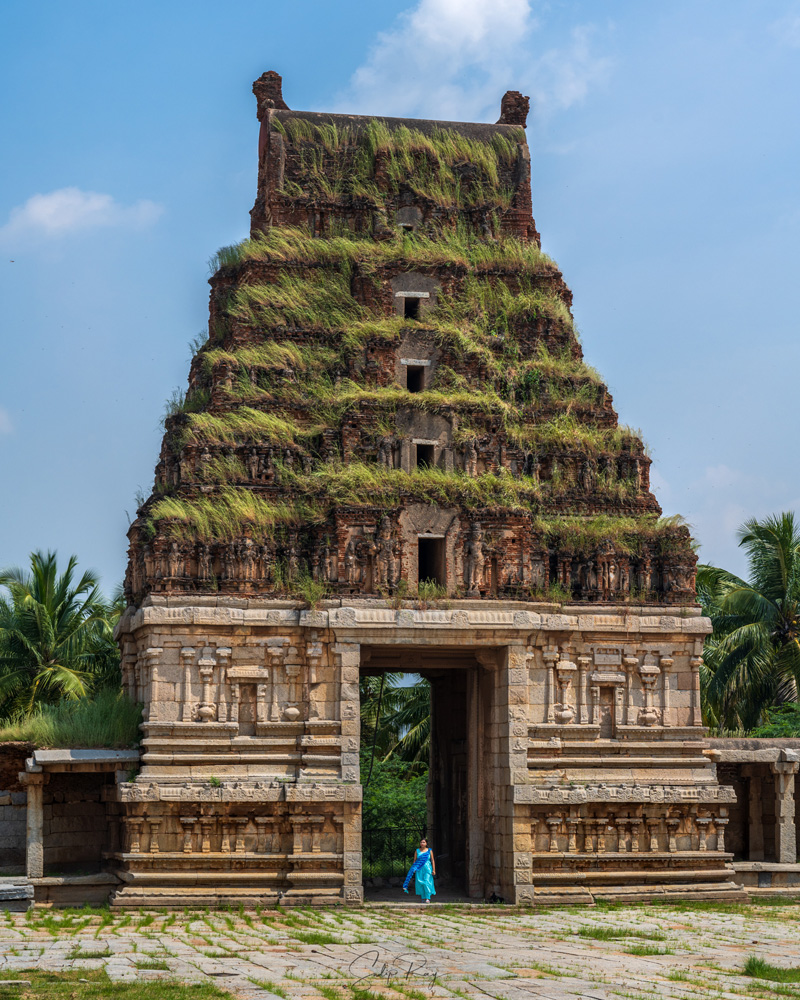
A short walk from the temple brought us to its ‘pushkarini’. We also visited the Domed Gateway nearby, which once served as an entrance to the urban cluster from the southeast.
Post-lunch, we decided to explore the Sacred Cluster of Hampi.
6. Narasimha Monolith:
This colossal statue, standing at 6.7 meters high, is extremely popular among tourists. It was commissioned by Krishnadevaraya in 1528 CE. The Narasimha is seated cross-legged beneath the Sheshanaga.
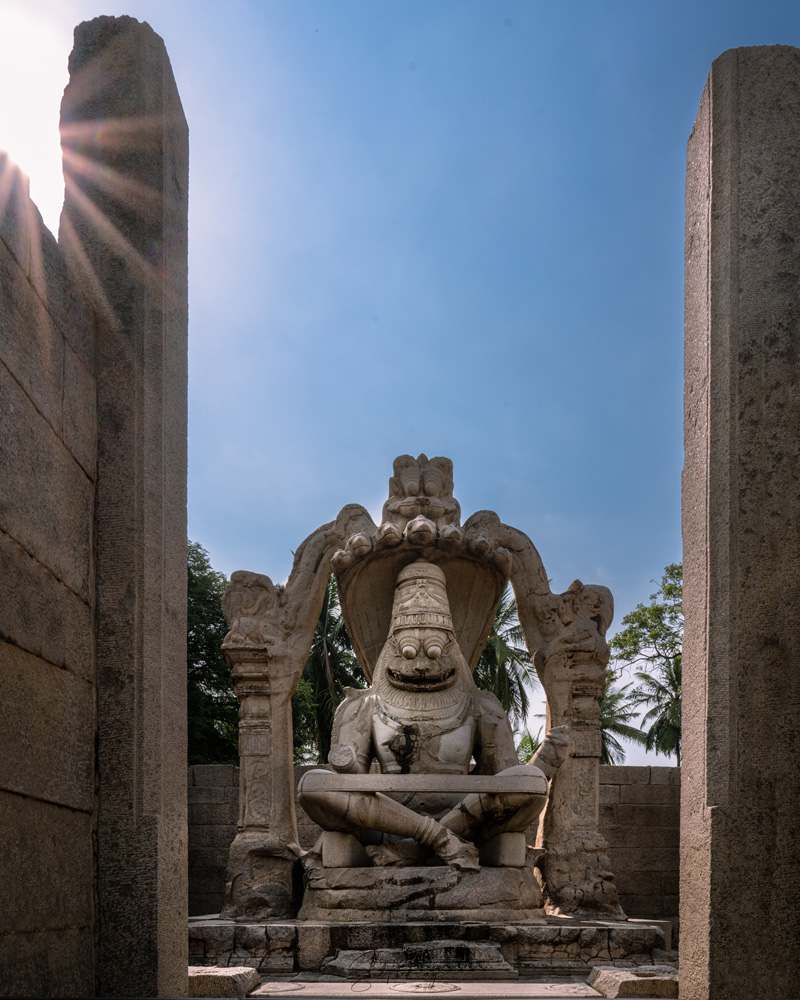
Originally, there was a statue of Lakshmi seated on the lap of Narasimha. Sadly, nothing is left of the figure of the goddess.
7. Badavi Linga:
Right next to the Narasimha statue, there is a monolithic Shiva linga, which is about 3 meters tall.

8. Krishna Temple:
This is another significant temple ruin of Hampi. It once formed the epicentre of the Krishnapura urban cluster.

The temple was commissioned by Krishnadevaraya in 1515 CE to celebrate his victory over the Gajapati rulers of the then Orissa. During its heyday, this temple housed a granite icon of infant Krishna, which was brought from Udaygiri.
9. Virupaksha Temple:
It is one of the few intact and active temples in Hampi, which remained unscathed from the destruction caused by the Sultanate. During the Vijayanagara Empire, it was the main temple and principal centre of pilgrimage. Even today, throngs of pilgrims visit this temple every day.

The temple is dedicated to Shiva, who is venerated as Virupaksha and Pampapathi here. Along with him, his two consorts – Pampa and Bhuwaneshwari – are also worshipped here.

10. Kadalekalu Ganesha:
After Virupaksha Temple, we went to the Hemkuta Hill. Here, we first visited Kadalekalu (roughly translated to gram seed) Ganesha.

The 4.5-meter-high statue has been carved out of a massive single boulder.
11. Sasivekalu Ganesha:
This is another prominent monolithic statue of Ganesha, rising at 2.4 meters. The word ‘sasivekalu’ locally means mustard seed.
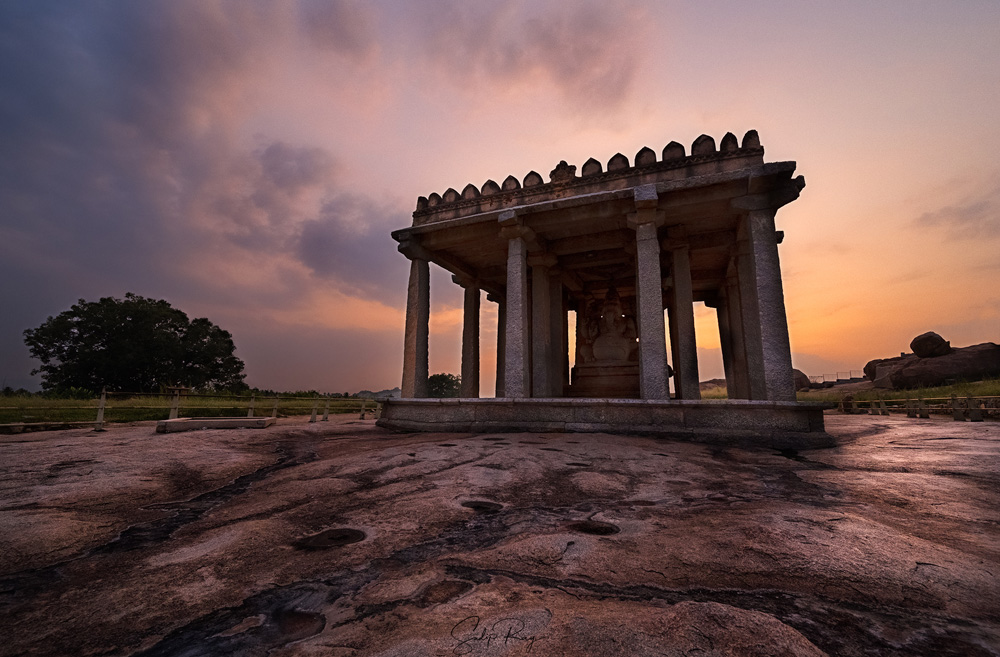
An inscription nearby informs that a merchant engaged in the business of mustard seed had commissioned this temple.
- The first day of exploring Hampi ended with catching the sunset at Hemkuta Hill.
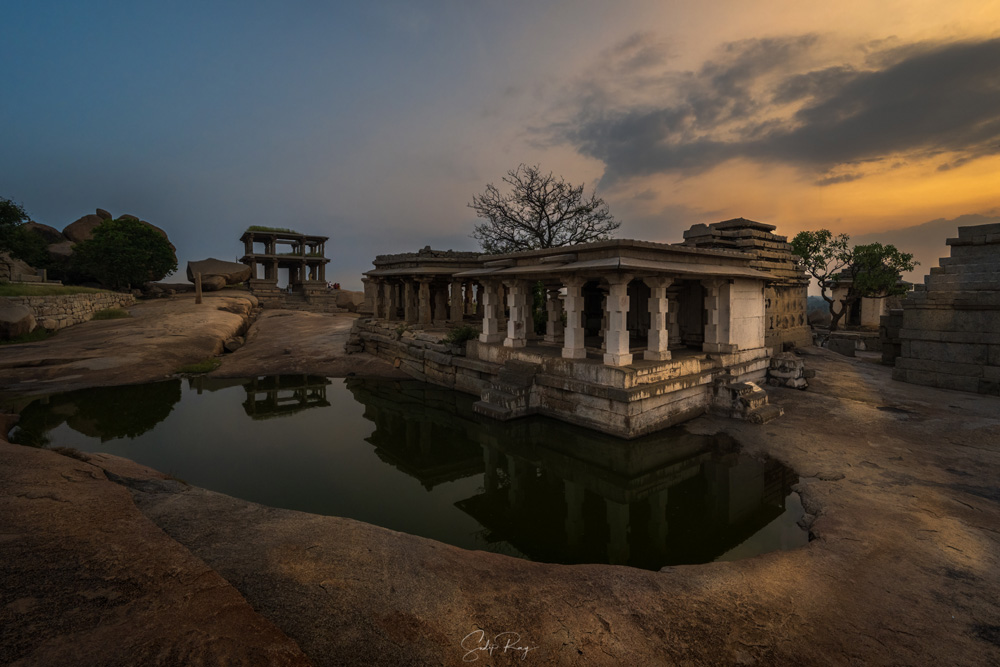
Day 2:
The first half of the second day was reserved for exploring the Royal Enclosure area.
1. Queen’s Bath:
One of the most attractive structures of the Royal Enclosure, the building is influenced by Indo-Islamic architecture.

The name, however, seems to be a misnomer. It was probably used by male courtiers and their female companions.
2. Mahanabami Dibba:
This raised platform was used by the Vijayanagara emperors for receiving honourable guests, watching army processions, games, and cultural performances, and most importantly celebrating the Navaratri festival.

Nothing exists in the upper portion of the platform. Only the base has survived the trial of time. It has countless carvings, which depict the day-to-day lives of the Empire.
From the top of the platform, the entire Royal Enclosure and palace area can be clearly seen. You can also check out the remains of various structures that have been excavated over the years.
3. Hazara Rama Temple:
This temple is another excellent specimen of Vijayanagara temple architecture. As it is located right in the middle of the Royal Enclosure, it is believed that the temple was exclusively used by the King.

This temple was built by Devaraya I of the Sangama dynasty in the early 15th CE. It was dedicated to Rama. The outer walls of the main temple have three tiers of carving, featuring 108 scenes from the Ramayana.
4. Zenana Enclosure:
This is a high-walled compound, which has two excavated palace structures and watchtowers. Contrary to popular belief, historians believe that the women of the Vijayanagara court did not live there. Since it is located in the vicinity of elephant stables and parade ground, the kings and their commanders most likely used it.
5. Lotus Mahal:
The Lotus Mahal is the most attractive structure inside the Zenana Enclosure.

It is characterized by a cluster of nine pyramidal towers and lobed arches.
6. Elephant Stable:
This is another specimen of Indo-Islamic architecture in Hampi. It comprises eleven chambers, each of which could accommodate two elephants.

After having our lunch and a bit of rest, we started the second phase of our exploration.
7. Coracle ride on Tungabhadra:
The coracle ride on Tungabhadra is one of the pleasant experiences in Hampi.
8. Kodandarama Temple and riverside sculptures:
The Kodandarama Temple is another active temple of Hampi. It is dedicated to Rama and his consort, Sita.
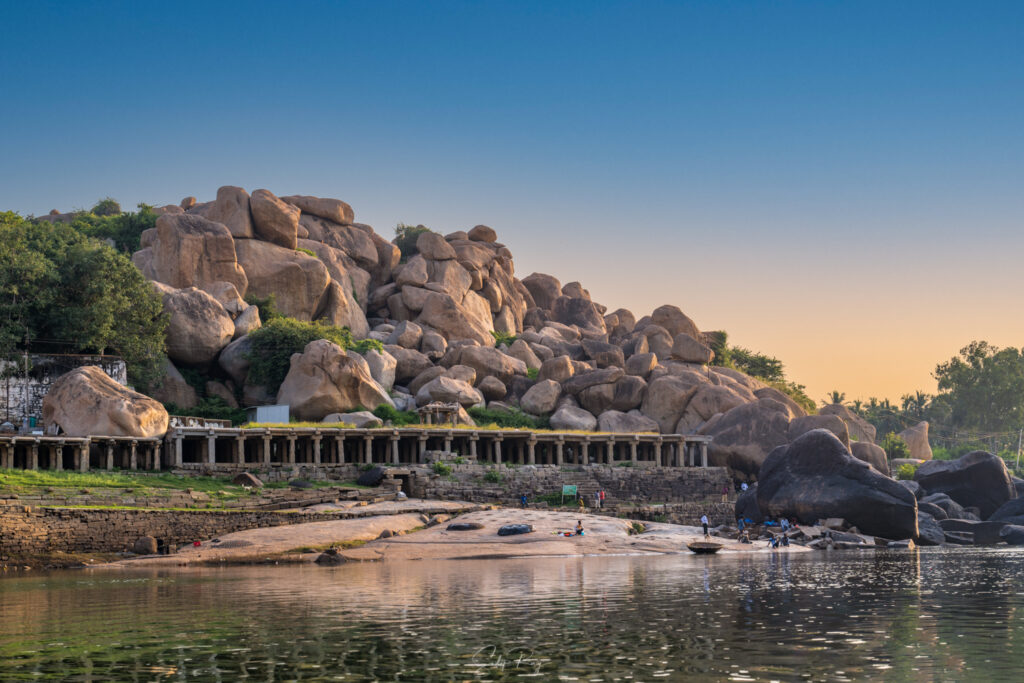
The surrounding area has many sculptures, notable among them are countless miniature lingas and a set of carvings portraying the avatars of Vishnu.
We also visited a cave temple, which remains submerged during the monsoon. It has interesting carvings of Shiva, Veerbhadra, a half-man and half-bull form of Nandi, etc.
9. Achyutaraya Temple:
It is also known as Tiruvengalanatha Temple. It was built in 1534 CE, not by Achyutaraya as the name suggests, but by his brother-in-law.

The temple is in a dilapidated state, although its grand scale and magnificence can still be asserted.
10. Matanga Hill:
We ended our day with another glorious sunset, watching it from the top of Matanga Hill.
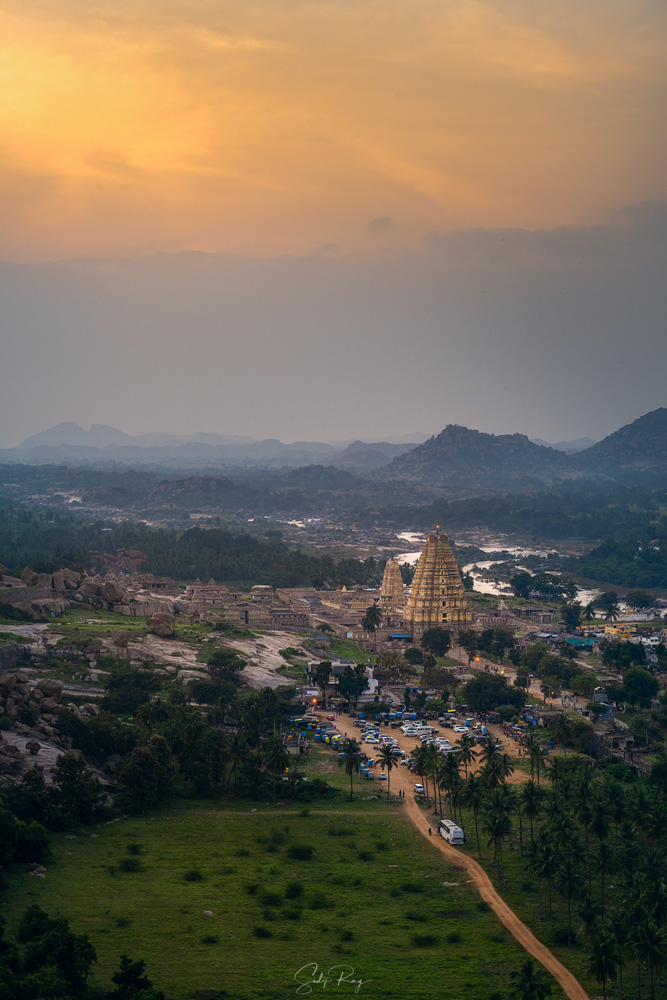
Day 3:
We started our third day by visiting the Archaeological Museum in Kamalpura. It has a fascinating collection of artefacts excavated from various sites of Hampi. The museum is divided into three galleries: the Shaiva Gallery, notable for life-size sculptures of Virbhadra and Bhairava; the Vishnu Gallery, showcasing statues of Garuda, Hanumana, Vishnu, and so on; and the General Gallery, displaying coins, weapons, copper plate inscriptions and such other artefacts of Vijayanagara Empire.
Afterward, we went to Anegundi, which was the first capital of Vijayanagara rulers. Anegundi is located on the northern bank of Tungabhadra. It is also believed to be the monkey kingdom of Kishkindha, as mentioned in the Ramayana.
The places of interest in Anegundi are as follows:
1. Anjanadri Hill:
It is believed to be the birthplace of Hanuman, the monkey god. You need to climb 575 steps to reach the top, which has a temple dedicated to Hanuman.
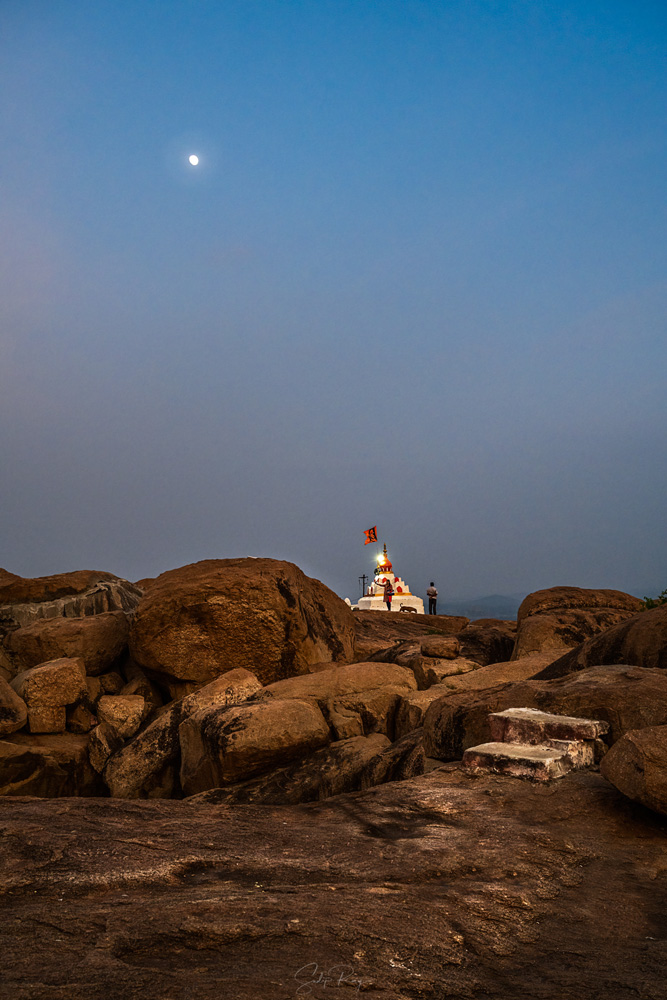
The Anjanadri Hill is also one of the best places to enjoy the sunset in Hampi. We were also amazed by the panoramic view of Hampi that this hill provided.
2. Anegundi Fort:
This was a fortified citadel, which housed a Durga temple and a Ganesha temple.
3. Pampa Sarovar:
This is a holy lake, where Pampa performed penance to show her devotion to Shiva.
4. Sanapur Lake:
It is one of the most scenic places in Anegundi. This natural lake is surrounded by stunning boulders and rocks, which further add to the charm of this place.

We loved this place as it was far less crowded than the rest of Hampi. We found it perfect for enjoying a bit of tranquillity. Also, coracle rides are available here.
Anegundi is also known for its picturesque rural beauty. It is dotted with paddy fields, banana plantations, and coconut groves.
2-days itinerary for Hampi:
If you are visiting Hampi for two days, you can opt for our plan for the first two days, following it to the T. You will have to give Anegundi a miss in that case.
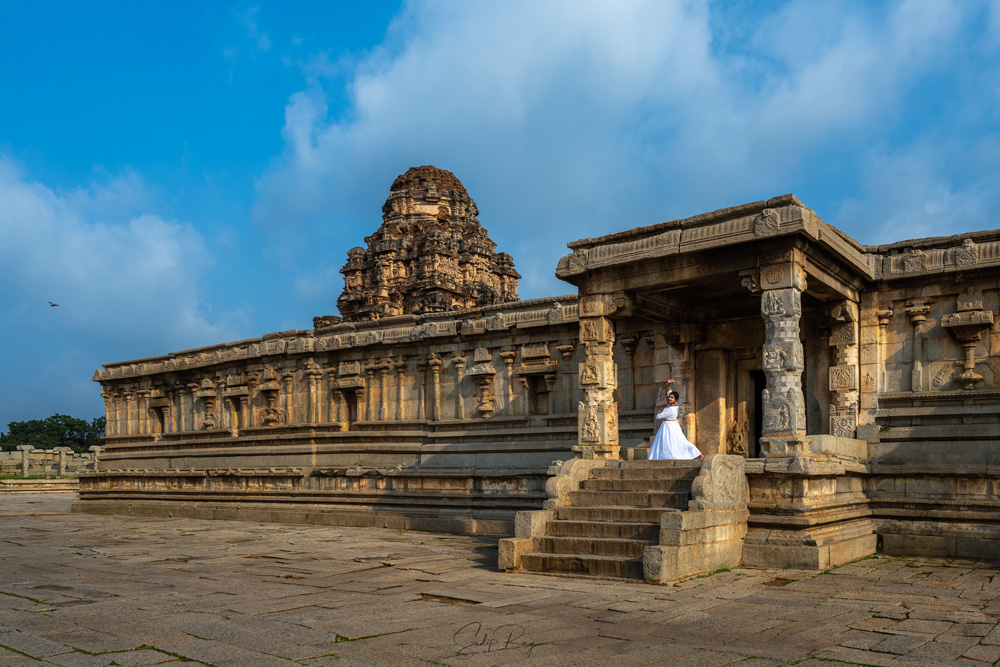
1-day itinerary for Hampi:
In case you have only one day to explore Hampi, we suggest visiting only the most important places. It will be impossible to cover all the places in a go.
Start early with Vijaya Vittala Temple. Then proceed to the Royal Enclosure and visit the Queen’s Bath, Mahanabami Platform, Hazara Rama Temple, Lotus Mahal, and Elephant Stable.
Grab a quick lunch and start exploring the Sacred Cluster. Start with the Narasimha monolith and continue with the Krishna Temple, Virupaksha Temple, Kadalekalu Ganesha, and Sasivekalu Ganesha. Finish your day’s trip by watching the sunset from Hemkuta Hill.

Things to remember:
1. The monuments in Hampi remain open from 6 AM to 6 PM.
2. The Archaeological Museum remains open from 10 AM to 5 PM. It is closed on Fridays.
3. Entry fees are required for visiting Virupaksha Temple, Vijaya Vittala Temple, and Zenana Enclosure. For the rest of the monuments, entry is free.
4. Drones and tripods are not allowed in Hampi.
5. The weather in Hampi is quite hot even at the end of October. Hence, we suggest starting as early as possible. Explore until lunch and take a break afterwards as the sun remains harshest between 12 PM to 3 PM. Start travelling again after 3 in the afternoon.
6. Though Hampi is known for mesmerizing sunsets, you can catch the sunrise from Matanaga Hill. However, the climb is a bit difficult as there is no paved way. It will be tricky to climb the precarious stairway before sunrise.
7. It is unsafe to travel around Hampi after sundown. Bears and leopards lurk around the hills and caves in the darkness.
8. Though the ambience of Hampi is quite chilled out, we suggest dressing modestly as most of the monuments in Hampi are religious in nature.
9. Carry an umbrella, wear hats and sunglasses, and drink plenty of water. Keep yourself hydrated with coconut water, which is easily available in Hampi.
10. Carry sufficient cash as ATMs in Hampi are mostly non-functional.
11. Both vegetarian and non-vegetarian food options are available in Hampi. The restaurants around Hampi Bazar however serve only veg. Some of the best eateries in Hampi are Mango Tree, Gopi Roof Restaurant, Ganesh Old Chillout, Funky Monkey, The Bridge, and Laughing Buddha.
12. We would suggest taking a guided tour of Hampi. It will make your tour more organized and you will get to know countless titbits about Hampi. We hired Mr. Bhanu. He was an excellent guide. He charged us INR 2000 per day. His contact number is 09449409070.
For reading about the Great Living Chola Temples of Thanjavur, visit our latest blog here.
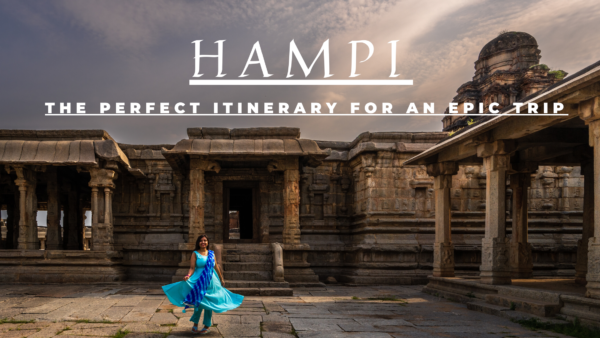
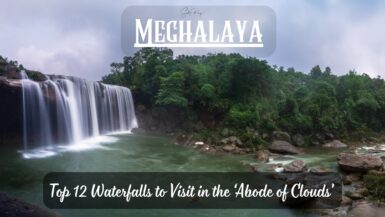


Thank you for the detailed information. Beautifully captured pictures!
Thank you for your appreciation!